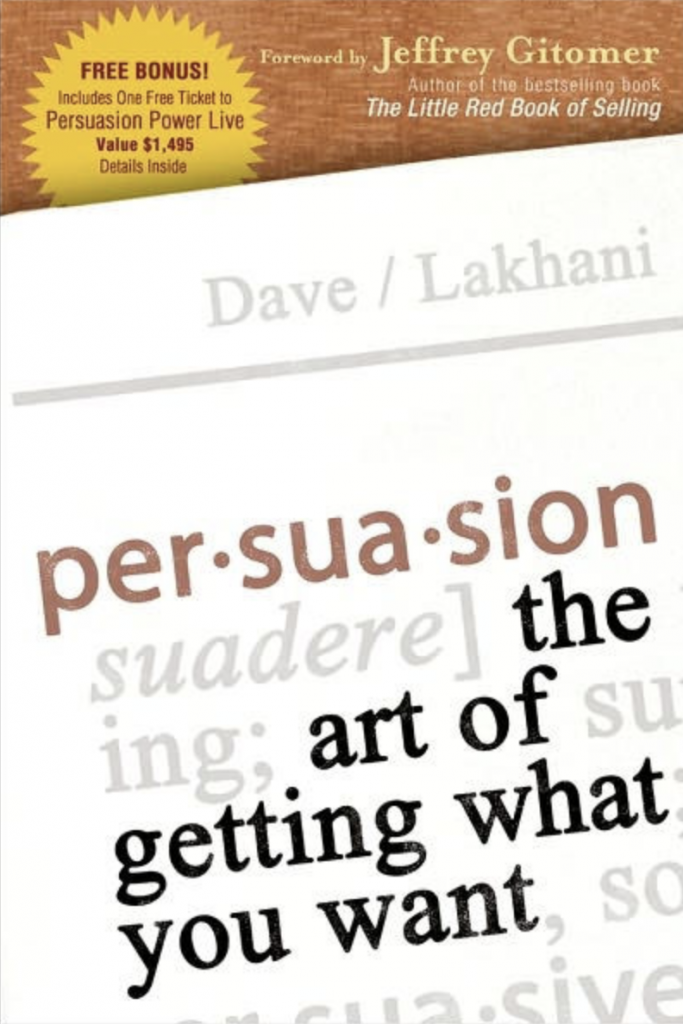Key Quote:
“Leave me penniless and naked in any town in America and by the end of the day I’ll have clothes, food, lodging, a way of earning an income, a following, and enough money in my pocket to start again. Why? Because I know exactly how to persuade people to do what I need them to do for both of us to achieve our goals” (p. xiii). — Dave Lakhani
Conditions of Manipulation / Persuasion. Certain conditions make people more available to manipulation or persuasion. They are:
• “The search for a solution”
• “Time sensitivity”
• “Potential for loss”
• “Encounter with a benevolent authority” (pp. 3-4)
Persuasion vs. Manipulation. The difference comes down to intent. Persuasion looks out for the needs of others and seeks to help each party achieve what you both want to achieve – persuasion
is a “win-win” proposition.
Manipulation. One path to temporary persuasion is manipulation, in which the only person who
benefits long-term is the manipulator.
Persuasion. “The art of persuasion is identifying what the people you are persuading want and
helping them achieve it” (p. 206).
Effective persuasion occurs when you understand the other person’s needs and goals and you can find common ground and belief. “Persuasion is an art form that improves through practice” (p. 14).
Six Tenets of Persuasion:
Outcome Based Best-Interest Focused
Truthful Goal & Time Oriented
Personal Ethical
Persona. Lakhani calls persona “the invisible persuader,” because people can be indirectly influenced by your persona before they even hear your direct message. Persona gives persuasiveness structure and support. How you look, dress, behave (“manners and mannerisms”), and otherwise communicate establishes your persona as persuasive – or not – to the particular audience you are seeking to reach (pp. 16-37).
Storytelling. “Stories slide past our logic and engage emotion.” And “successful stories shift the criteria of the person you are persuading” (p. 63). When you’re trying to influence an audience, you are telling a story designed to gently interrupt, compel, persuade, and encourage the audience to take some action.
Gurudom. People listen to experts. Identify your area of expertise, hone in on and develop it, and make the most of it. Write articles, develop a blog or website, buy a spot on AM radio in your hometown, or even write a book.
Desire to Believe. “Understanding the beliefs of the people you are trying to persuade allows you to focus on building on their current beliefs rather than trying to change them or create a new belief” (p. 93).
Familiarity. “Try to move all of your persuasive conversations from a shared commonality to a new, shared experience that you will create together” (p. 101).
Exclusivity. “The more exclusive you can make someone feel, the more likely they are to be persuaded.” “Exclusivity is closely tied to identity” (p. 110).
Curiosity. Set up conversations with your audience that encourage “the discovery of new information that will help others make the only logical decision they can” (p. 117).
Relevancy. “Your pitch had better be immediately relevant to me or I’ll destroy you with apathy” (p. 119). Have you “gathered the right group of people” so that what you are proposing addresses what they need (p. 123)?
The Persuasion Equation. The basic approach for persuading people in any endeavor (selling, advertising, negotiating, etc.) is summed up by Lakhani’s equation Position + Presentation X Influence = Persuasion (p. 157).
“Clearly define the message you are going to send as well as your desired outcome,” “clearly identify your audience before you present,” and “layer the elements of persuasion as appropriate throughout your message to intensify the impact” (p. 157).
Negotiation. Negotiation is “a patient game of questioning. The more information you can gather from the person with whom you are negotiating about her personal outcomes as well as her personal beliefs about the process, the more likely you will be to present an agreeable outcome” (p. 191).
Hewlett, S.A. (2009). Top Talent: Keeping Performance Up When Business Is Down. Boston: Harvard Business Press.

The difference comes down to intent. Persuasion looks out for the needs of others and seeks to help each party achieve what you both want to achieve – persuasion is a “win-win” proposition.
